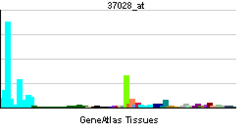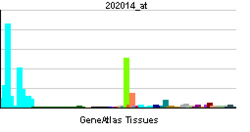PPP1R15A
| Protein phosphatase 1, regulatory subunit 15A | |||||||||||||
|---|---|---|---|---|---|---|---|---|---|---|---|---|---|
| Identifiers | |||||||||||||
| Symbols | PPP1R15A ; GADD34 | ||||||||||||
| External IDs | OMIM: 611048 MGI: 1100516 HomoloGene: 8639 GeneCards: PPP1R15A Gene | ||||||||||||
| |||||||||||||
| RNA expression pattern | |||||||||||||
 | |||||||||||||
 | |||||||||||||
| More reference expression data | |||||||||||||
| Orthologs | |||||||||||||
| Species | Human | Mouse | |||||||||||
| Entrez | 23645 | 17872 | |||||||||||
| Ensembl | ENSG00000087074 | ENSMUSG00000040435 | |||||||||||
| UniProt | O75807 | P17564 | |||||||||||
| RefSeq (mRNA) | NM_014330 | NM_008654 | |||||||||||
| RefSeq (protein) | NP_055145 | NP_032680 | |||||||||||
| Location (UCSC) | Chr 19: 49.38 – 49.38 Mb | Chr 7: 45.52 – 45.53 Mb | |||||||||||
| PubMed search | |||||||||||||
Protein phosphatase 1 regulatory subunit 15A also known as growth arrest and DNA damage-inducible protein GADD34 is a protein that in humans is encoded by the PPP1R15A gene.[1][2][3]
The Gadd34/MyD116 gene was originally discovered as a member in a set of gadd and MyD mammalian genes encoding acidic proteins that synergistically suppress cell growth.[4] Later on it has been characterized as a gene playing a role in ER stress-induced cell death, being a target of ATF4 that plays a role in ER-mediated cell death via promoting protein dephosphorylation of elF2α and reversing translational inhibition.[5]
Function
This gene is a member of a group of genes whose transcript levels are increased following stressful growth arrest conditions and treatment with DNA-damaging agents. The induction of this gene by ionizing radiation occurs in certain cell lines regardless of p53 status, and its protein response is correlated with apoptosis following ionizing radiation.[3]
Interactions
PPP1R15A has been shown to interact with:
References
- ↑ Hollander MC, Zhan Q, Bae I, Fornace AJ Jr (Jul 1997). "Mammalian GADD34, an apoptosis- and DNA damage-inducible gene". J Biol Chem 272 (21): 13731–7. doi:10.1074/jbc.272.21.13731. PMID 9153226.
- ↑ Korabiowska M, Betke H, Kellner S, Stachura J, Schauer A (Jan 1998). "Differential expression of growth arrest, DNA damage genes and tumour suppressor gene p53 in naevi and malignant melanomas". Anticancer Res 17 (5A): 3697–700. PMID 9413226.
- ↑ 3.0 3.1 "Entrez Gene: PPP1R15A protein phosphatase 1, regulatory (inhibitor) subunit 15A".
- ↑ Zhan Q, Lord KA, Alamo I, Hollander MC, Carrier F, Ron D, Kohn KW, Hoffman B, Liebermann DA, Fornace AJ (April 1994). "The gadd and MyD genes define a novel set of mammalian genes encoding acidic proteins that synergistically suppress cell growth". Mol. Cell. Biol. 14 (4): 2361–71. doi:10.1128/mcb.14.4.2361. PMC 358603. PMID 8139541.
- ↑ Sano R, Reed JC (July 2013). "ER stress-induced cell death mechanisms". Biochim. Biophys. Acta 1833 (12): 3460–70. doi:10.1016/j.bbamcr.2013.06.028. PMID 23850759.
- ↑ 6.0 6.1 Hung WJ, Roberson RS, Taft J, Wu DY (2003). "Human BAG-1 proteins bind to the cellular stress response protein GADD34 and interfere with GADD34 functions". Mol. Cell. Biol. 23 (10): 3477–86. doi:10.1128/MCB.23.10.3477-3486.2003. PMC 164759. PMID 12724406.
- ↑ Grishin AV, Azhipa O, Semenov I, Corey SJ (2001). "Interaction between growth arrest-DNA damage protein 34 and Src kinase Lyn negatively regulates genotoxic apoptosis". Proc. Natl. Acad. Sci. U.S.A. 98 (18): 10172–7. doi:10.1073/pnas.191130798. PMC 56934. PMID 11517336.
- ↑ 8.0 8.1 Adler HT, Chinery R, Wu DY, Kussick SJ, Payne JM, Fornace AJ, Tkachuk DC (1999). "Leukemic HRX fusion proteins inhibit GADD34-induced apoptosis and associate with the GADD34 and hSNF5/INI1 proteins". Mol. Cell. Biol. 19 (10): 7050–60. PMC 84700. PMID 10490642.
- ↑ 9.0 9.1 9.2 9.3 Wu DY, Tkachuck DC, Roberson RS, Schubach WH (2002). "The human SNF5/INI1 protein facilitates the function of the growth arrest and DNA damage-inducible protein (GADD34) and modulates GADD34-bound protein phosphatase-1 activity". J. Biol. Chem. 277 (31): 27706–15. doi:10.1074/jbc.M200955200. PMID 12016208.
- ↑ 10.0 10.1 10.2 Connor JH, Weiser DC, Li S, Hallenbeck JM, Shenolikar S (2001). "Growth arrest and DNA damage-inducible protein GADD34 assembles a novel signaling complex containing protein phosphatase 1 and inhibitor 1". Mol. Cell. Biol. 21 (20): 6841–50. doi:10.1128/MCB.21.20.6841-6850.2001. PMC 99861. PMID 11564868.
- ↑ Hasegawa T, Isobe K (1999). "Evidence for the interaction between Translin and GADD34 in mammalian cells". Biochim. Biophys. Acta 1428 (2-3): 161–8. doi:10.1016/s0304-4165(99)00060-4. PMID 10434033.
Further reading
- Maruyama K, Sugano S (1994). "Oligo-capping: a simple method to replace the cap structure of eukaryotic mRNAs with oligoribonucleotides.". Gene 138 (1-2): 171–4. doi:10.1016/0378-1119(94)90802-8. PMID 8125298.
- Suzuki Y, Yoshitomo-Nakagawa K, Maruyama K et al. (1997). "Construction and characterization of a full length-enriched and a 5'-end-enriched cDNA library.". Gene 200 (1-2): 149–56. doi:10.1016/S0378-1119(97)00411-3. PMID 9373149.
- Hasegawa T, Isobe K (1999). "Evidence for the interaction between Translin and GADD34 in mammalian cells.". Biochim. Biophys. Acta 1428 (2-3): 161–8. doi:10.1016/s0304-4165(99)00060-4. PMID 10434033.
- Adler HT, Chinery R, Wu DY et al. (2000). "Leukemic HRX fusion proteins inhibit GADD34-induced apoptosis and associate with the GADD34 and hSNF5/INI1 proteins.". Mol. Cell. Biol. 19 (10): 7050–60. PMC 84700. PMID 10490642.
- Hasegawa T, Yagi A, Isobe K (2000). "Interaction between GADD34 and kinesin superfamily, KIF3A.". Biochem. Biophys. Res. Commun. 267 (2): 593–6. doi:10.1006/bbrc.1999.1991. PMID 10631107.
- Hasegawa T, Xiao H, Hamajima F, Isobe K (2001). "Interaction between DNA-damage protein GADD34 and a new member of the Hsp40 family of heat shock proteins that is induced by a DNA-damaging reagent.". Biochem. J. 352 (3): 795–800. doi:10.1042/0264-6021:3520795. PMC 1221519. PMID 11104688.
- Grishin AV, Azhipa O, Semenov I, Corey SJ (2001). "Interaction between growth arrest-DNA damage protein 34 and Src kinase Lyn negatively regulates genotoxic apoptosis.". Proc. Natl. Acad. Sci. U.S.A. 98 (18): 10172–7. doi:10.1073/pnas.191130798. PMC 56934. PMID 11517336.
- Connor JH, Weiser DC, Li S et al. (2001). "Growth arrest and DNA damage-inducible protein GADD34 assembles a novel signaling complex containing protein phosphatase 1 and inhibitor 1.". Mol. Cell. Biol. 21 (20): 6841–50. doi:10.1128/MCB.21.20.6841-6850.2001. PMC 99861. PMID 11564868.
- Wu DY, Tkachuck DC, Roberson RS, Schubach WH (2002). "The human SNF5/INI1 protein facilitates the function of the growth arrest and DNA damage-inducible protein (GADD34) and modulates GADD34-bound protein phosphatase-1 activity.". J. Biol. Chem. 277 (31): 27706–15. doi:10.1074/jbc.M200955200. PMID 12016208.
- Korabiowska M, Cordon-Cardo C, Betke H et al. (2003). "GADD153 is an independent prognostic factor in melanoma: immunohistochemical and molecular genetic analysis.". Histol. Histopathol. 17 (3): 805–11. PMID 12168790.
- Strausberg RL, Feingold EA, Grouse LH et al. (2003). "Generation and initial analysis of more than 15,000 full-length human and mouse cDNA sequences.". Proc. Natl. Acad. Sci. U.S.A. 99 (26): 16899–903. doi:10.1073/pnas.242603899. PMC 139241. PMID 12477932.
- Brush MH, Weiser DC, Shenolikar S (2003). "Growth arrest and DNA damage-inducible protein GADD34 targets protein phosphatase 1 alpha to the endoplasmic reticulum and promotes dephosphorylation of the alpha subunit of eukaryotic translation initiation factor 2.". Mol. Cell. Biol. 23 (4): 1292–303. doi:10.1128/MCB.23.4.1292-1303.2003. PMC 141149. PMID 12556489.
- Hung WJ, Roberson RS, Taft J, Wu DY (2003). "Human BAG-1 proteins bind to the cellular stress response protein GADD34 and interfere with GADD34 functions.". Mol. Cell. Biol. 23 (10): 3477–86. doi:10.1128/MCB.23.10.3477-3486.2003. PMC 164759. PMID 12724406.
- Hollander MC, Poola-Kella S, Fornace AJ (2003). "Gadd34 functional domains involved in growth suppression and apoptosis.". Oncogene 22 (25): 3827–32. doi:10.1038/sj.onc.1206567. PMID 12813455.
- Powolny A, Takahashi K, Hopkins RG, Loo G (2004). "Induction of GADD gene expression by phenethylisothiocyanate in human colon adenocarcinoma cells.". J. Cell. Biochem. 90 (6): 1128–39. doi:10.1002/jcb.10733. PMID 14635187.
- Ota T, Suzuki Y, Nishikawa T et al. (2004). "Complete sequencing and characterization of 21,243 full-length human cDNAs.". Nat. Genet. 36 (1): 40–5. doi:10.1038/ng1285. PMID 14702039.
- Shi W, Sun C, He B et al. (2004). "GADD34-PP1c recruited by Smad7 dephosphorylates TGFbeta type I receptor.". J. Cell Biol. 164 (2): 291–300. doi:10.1083/jcb.200307151. PMC 2172339. PMID 14718519.
- Colland F, Jacq X, Trouplin V et al. (2004). "Functional proteomics mapping of a human signaling pathway.". Genome Res. 14 (7): 1324–32. doi:10.1101/gr.2334104. PMC 442148. PMID 15231748.